Key takeaways:
- Data integrity relies on access controls, transactions, and proper database systems to maintain the accuracy and consistency of information.
- Implementing ACID properties and monitoring transaction performance are crucial for preventing errors and ensuring reliable system operations.
- Identifying and troubleshooting common transaction issues, such as network latency and locking conflicts, is essential for preserving data integrity and enhancing user experience.
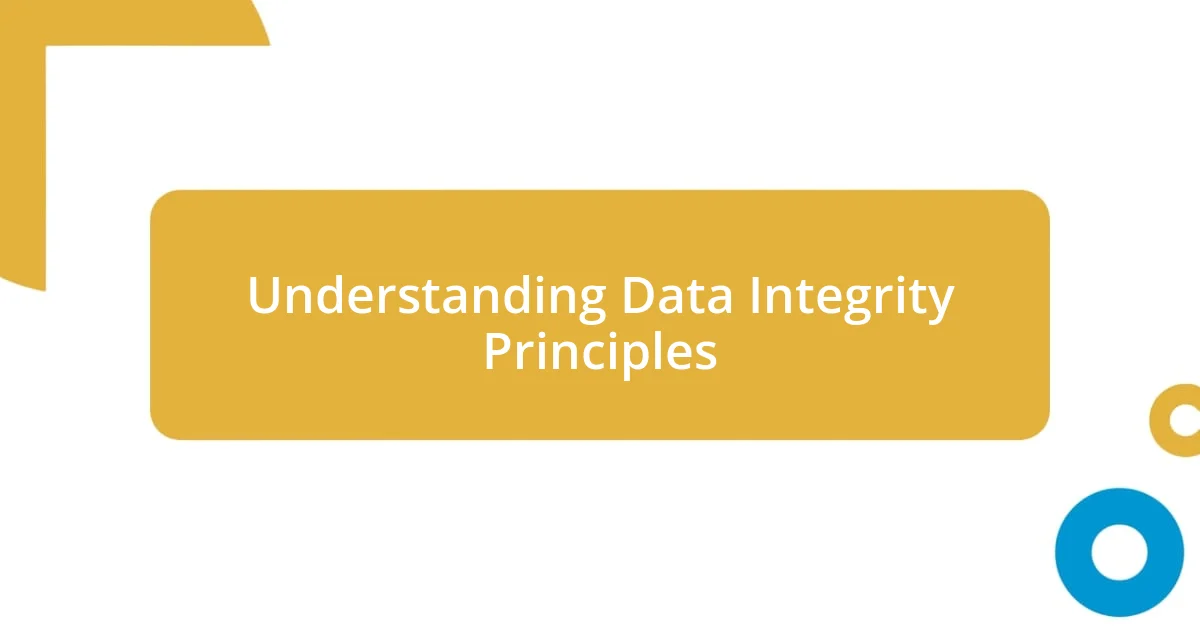
Understanding Data Integrity Principles
Data integrity is all about maintaining the accuracy and consistency of data over its entire lifecycle. I remember a project where discrepancies in financial records nearly derailed our budget forecasts. That experience taught me how critical it is to ensure that data remains reliable and unchanged unless authorized changes are made.
One key principle of data integrity is ensuring that only authorized users can modify the data. It’s fascinating—have you ever thought about how easy it can be to accidentally delete or alter important information? In my early days, I once clicked the wrong button and wiped out a significant dataset. That mishap was a wake-up call that emphasized the necessity of access controls and audit trails to track changes.
Additionally, I’ve seen firsthand how using transactions can help maintain data integrity during complex operations. For instance, in a recent database migration, we implemented a transactional system that allowed us to roll back changes in case something went wrong. This capability not only safeguarded our data but also gave us the confidence to proceed, knowing that we weren’t at risk of losing critical information. Isn’t it reassuring to know that with the right principles in place, the integrity of your data can be effectively protected?
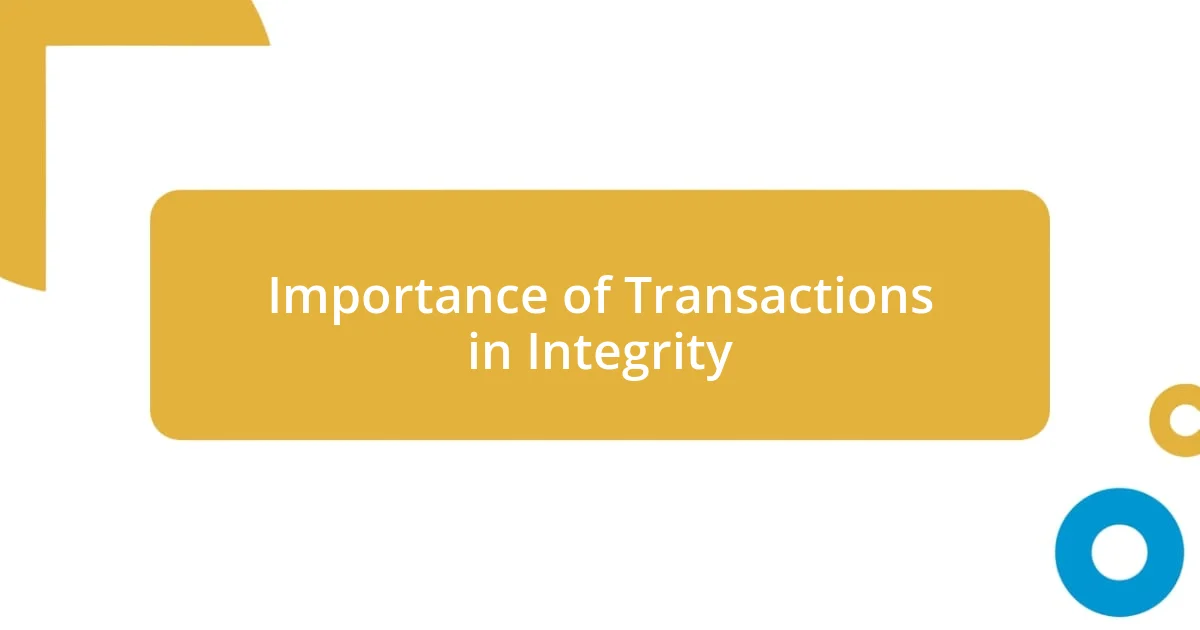
Importance of Transactions in Integrity
Transactions play a vital role in ensuring data integrity by providing a structured way to execute changes while guaranteeing that each step is completed correctly. During my tenure working on a high-stakes inventory management system, I witnessed how a single failed process could lead to inaccurate stock levels, potentially costing the company significant revenue. With transactions in place, we could either completely apply or roll back changes, preserving the accuracy of our records and preventing chaos.
- Transactions ensure that all parts of a complex operation either succeed or fail together, maintaining consistency.
- They prevent partial updates, which can lead to data corruption or inaccuracies.
- Using transactions, I’ve observed firsthand that teams can work with greater confidence, knowing their data won’t be compromised by incomplete actions.
- The rollback functionality gives you peace of mind during high-pressure situations, making it easier to focus on execution rather than worry about potential errors.
- Implementing transactions also fosters collaboration, as team members can experiment and innovate without fear of devastating consequences.
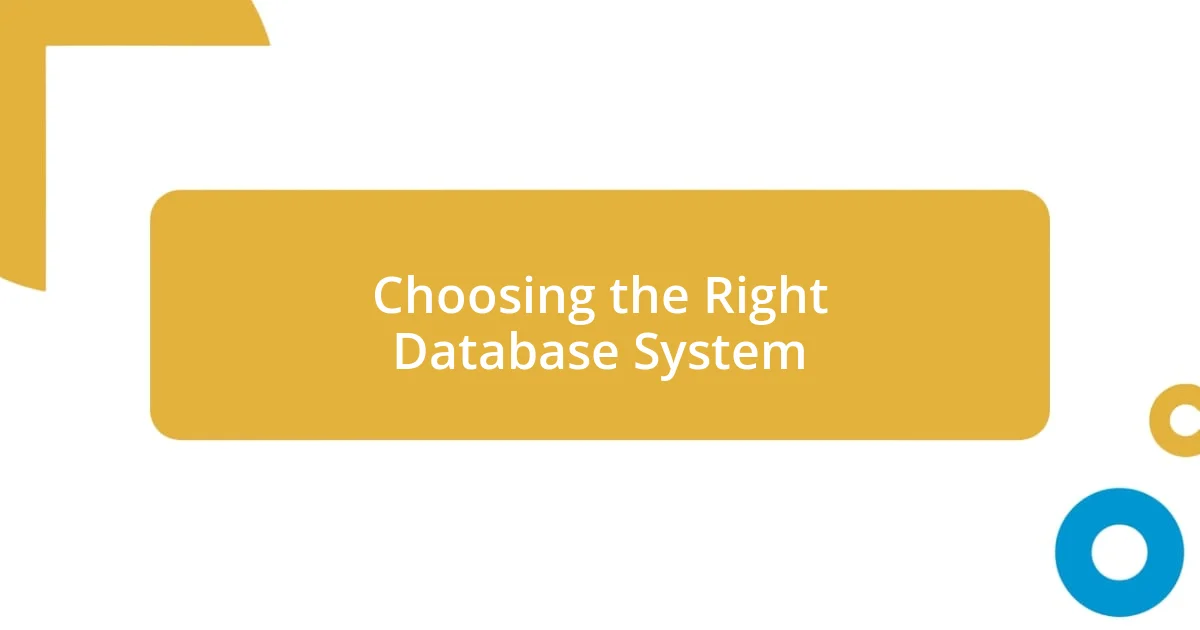
Choosing the Right Database System
Choosing the right database system is essential for maintaining data integrity. I remember considering various systems for a client project, weighing their strengths and weaknesses. The choice between SQL and NoSQL often boils down to the specific requirements of the application. For structured data that requires strong integrity, I found traditional relational databases like PostgreSQL to be invaluable. Conversely, if the project demands flexibility and scalability, a NoSQL option like MongoDB can shine.
In some instances, I’ve noticed that the complexity of the database can impact transaction handling. A simpler database system often eases transaction management. Take my experience with an e-commerce platform: we opted for a lightweight SQL database. Despite the project’s rapid growth, the transactions remained smooth and reliable. This stability helped us avoid costly errors that can occur when data integrity is compromised.
To make an informed decision, it’s crucial to consider factors such as transaction support, performance, and your team’s expertise with each system. Have you ever been stuck choosing between two technologies that both seem great? I was in that position once, torn between a robust system and a fast, agile solution. I learned that sometimes you have to prioritize what matters most for your project. A well-researched choice not only ensures data integrity but also fosters long-term success.
| Database Type | Strengths |
|---|---|
| SQL | Strong data integrity, structured schema, ACID transactions |
| NoSQL | Flexibility, scalability, high availability |

Implementing ACID Properties Effectively
Implementing ACID properties effectively is crucial for maintaining robust data integrity. I can recall grappling with the complexities of ensuring Atomicity in a project where a banking application had to process multiple transactions simultaneously. The stakes were high; if something were to fail midway, it could lead to severe financial discrepancies. We built a mechanism that grouped these transactions, guaranteeing they either all completed successfully or none did, providing a solid safety net.
Consistency is another cornerstone of the ACID framework that I’ve seen emphasized in various projects. I remember working on a client’s order processing system where maintaining a consistent state across multiple tables was a challenge. By applying strict validation rules and leveraging the database’s features, we ensured that even in the event of a system crash, the integrity remained intact. This attention to detail not only saved us from potential disasters but also built trust with our users. How often have you had to face the uncertainty of data corruption? It’s an unsettling feeling, one that I’ve learned to mitigate through rigorous testing of consistency protocols.
Isolation is something I can’t stress enough. In collaborative environments, conflicts can arise when multiple users attempt to modify the same data. I’ve had experiences where a lack of proper isolation led to data anomalies that took days to resolve. By implementing transaction isolation levels suited to each situation, we not only minimized these conflicts but also enhanced performance. The clarity this brought to the team was palpable; instead of worrying about competing updates, they could focus on their contributions, driving innovation. Doesn’t it feel empowering to work without that cloud of uncertainty hanging overhead?
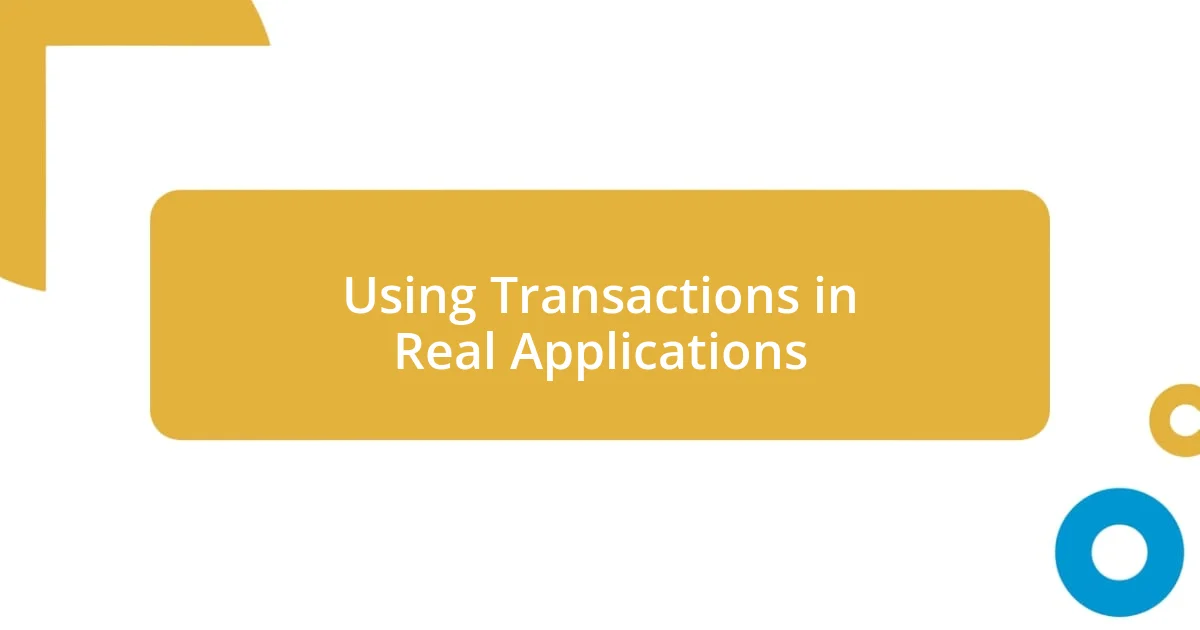
Using Transactions in Real Applications
Using transactions in real applications can create a seamless experience, but it requires thoughtful planning. I once worked on a financial platform where ensuring that a user’s transaction completed successfully was paramount. We used database transactions to encapsulate operations, which transformed potential failures into smooth recoveries. It felt reassuring knowing that if one step faltered, the entire transaction could roll back, leaving the system in a consistent state. Have you ever felt the weight of a faulty transaction looming over your project? I can certainly relate.
On another occasion, I developed a project for inventory management where the fast-paced nature of sales demanded immediate updates. Here, the use of transactions became a lifesaver when simultaneous updates could otherwise lead to overselling products. I implemented a strategy that included a locking mechanism to manage conflicts, allowing transactions to process safely even under high demand. The relief in my team was palpable whenever we received positive feedback from customers about our system’s reliability. Isn’t it fascinating how technology can bridge the gap between chaos and order?
Moreover, I’ve witnessed firsthand how poorly implemented transactions can unravel a project. During a high-traffic event, we faced a surge in traffic, and without robust transaction management, our application began to falter. It’s a daunting experience when you realize that a small oversight can lead to cascading failures. The lessons I took from that experience taught me that prioritizing transaction integrity isn’t just about preventing errors; it’s about building trust with users who rely on your application to function flawlessly. Can you imagine what it’s like to promise reliability and then falter? That thought drives me to advocate for meticulous transaction design every single time.
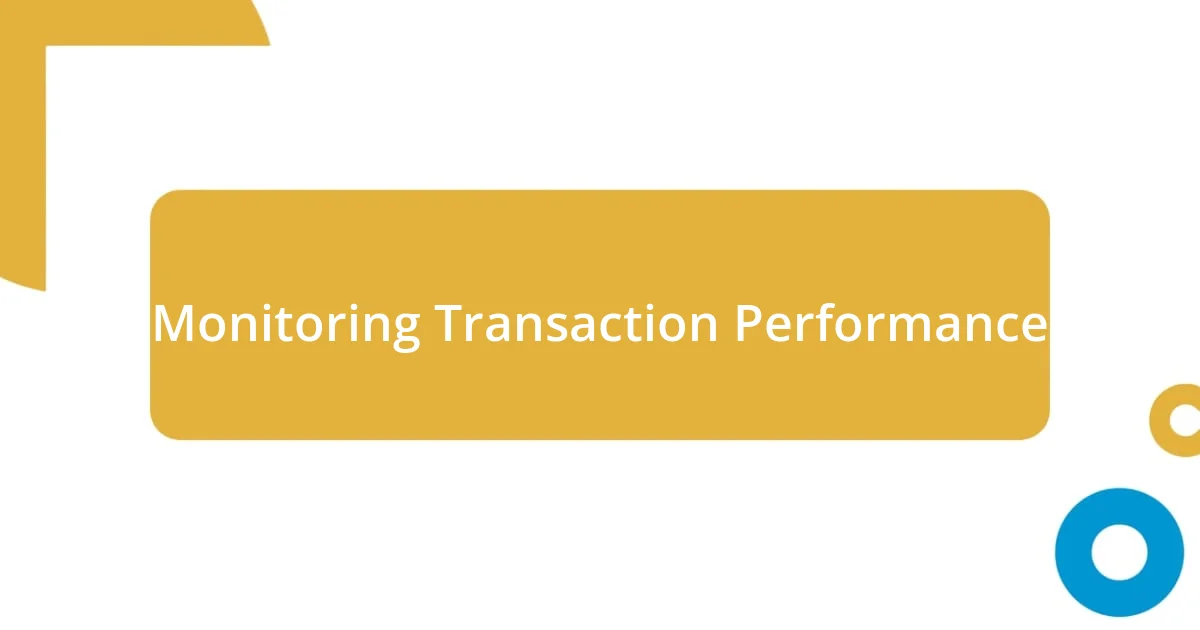
Monitoring Transaction Performance
Monitoring transaction performance is vital for understanding how well our systems operate. In my experience, I’ve noticed that slow transactions can be a silent killer, gradually degrading user experience without immediate notice. During one project, I implemented monitoring tools that alerted us when transaction times exceeded acceptable thresholds. It felt like having an unseen guardian, allowing us to act quickly before users were affected. Isn’t it a comfort to know we can preemptively tackle issues before they escalate?
Through detailed logging, I’ve also been able to analyze transaction patterns over time. Once, while troubleshooting a recurring issue with a payment gateway, I discovered that peak transaction times corresponded with unexpected system slowdowns. This insight led me to optimize our database queries and improve throughput when it mattered most. These adjustments were transformative, reducing transaction times significantly and boosting user satisfaction. Have you ever analyzed system behavior and uncovered a treasure trove of insights?
Incorporating performance metrics into our daily operations created a culture of accountability within the team. I remember when we started sharing transaction performance reports; it sparked a newfound enthusiasm among team members to contribute to system efficiency. By making this data accessible, we fostered a sense of ownership that helped ensure our application remains smooth and reliable. Isn’t it incredible how a few metrics can empower a whole team to rally around improvements?
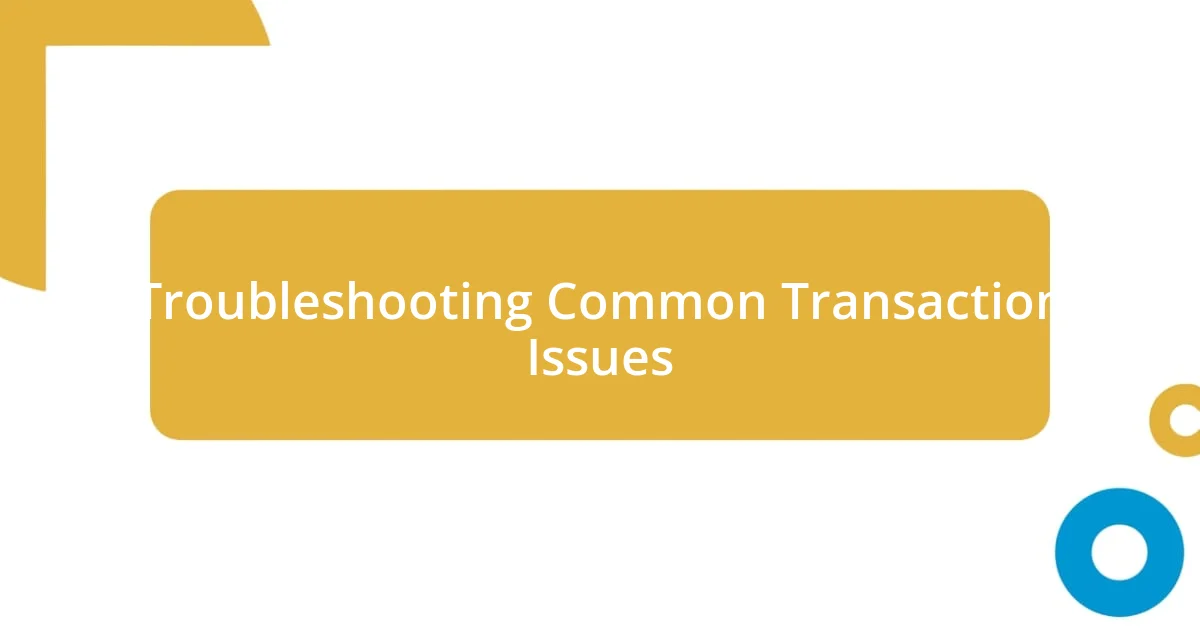
Troubleshooting Common Transaction Issues
When troubleshooting transaction issues, identifying the root cause is essential. There was a time when I encountered a baffling problem: transactions were intermittently failing. After some digging, I found that the culprit was a network latency issue between our application and the database. It was frustrating, but pinpointing the problem felt like finding the missing piece of a puzzle. Have you ever resolved a stubborn technical glitch that just wouldn’t go away?
Another common issue comes from locking conflicts, especially in high-traffic systems. I remember vividly when our order processing system faced a deadlock due to simultaneous requests trying to update inventory. The tension in our team was palpable as we scrambled to fix it. By introducing a retry mechanism with exponential backoff, we alleviated the deadlock without impacting user experience. That experience taught me the importance of robust error handling. Isn’t it interesting how often seemingly small changes can lead to significant improvements?
Lastly, inadequate isolation levels can lead to dirty reads or phantom reads, which compromise data integrity. I recall when I was part of a team that faced inconsistent reporting during a crucial sales campaign. By switching the isolation level from Read Committed to Repeatable Read, we created a more stable environment for transaction processing. The relief was immense when we saw accurate data flowing through without discrepancies. Have you ever realized the profound impact of isolation levels on the integrity of your systems? It’s a reminder that vigilance in transaction management can save a project from chaos.














